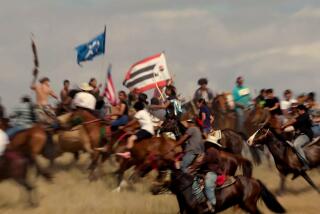Healing Old Wounds in Minnesota : Sculpture Recalls 1862 Indian Conflict
- Share via
MINNEAPOLIS — On the banks of the Minnesota River, at a place of sorrow and sacredness for Minnesota Sioux Indians, a young man has come home to help heal old wounds in this Year of Reconciliation.
Sculptor Tom Meagher Miller, 27, who claims only a trace of Indian blood, has finished chiseling a seven-foot sandstone Sioux warrior to be placed near the scene in Mankato where 38 members of the tribe were hanged on Christmas Day 125 years ago in the largest mass execution in U.S. history.
“I wanted the sculpture to represent the Dakota Indians as a whole and especially the 38 who were hanged,” Miller said in a telephone interview.
Gov. Rudy Perpich proclaimed 1987 to be the Year of Reconciliation in memory of the bloody 1862 conflict between the Sioux and white settlers and the hangings that followed.
Miller, who grew up in Mankato, was living in Colorado when he heard of the proclamation a year ago and immediately proposed a sculpture memorial. He has spent the last several months working on the statue at his grandparents’ farm near Madison Lake, which has been in the family for 150 years.
“My ancestors on both sides may have played a part in the conflict, but that is not why I’m involved,” he said. “I have only a trace of Indian blood, but it has seemed to increase since I was born.”
For years after the conflict, in which hundreds of white settlers were slain, Indians were given most of the blame. Historians later put much of the blame on federal policies of herding Indians onto reservations and then abusing them through agents who often failed to deliver promised payments.
The Indians had gone through a period of extreme hunger, which was believed to have sparked the attacks on the whites. The Civil War was being fought and the federal government was reluctant and late in sending troops. Much of the defense was made up of ragtag volunteers and surviving settlers.
Although history has been kinder to the Indians, some Indian leaders and others have felt that the conflict has never been fully appreciated by many people.
Because of the hangings in Mankato, Miller said, he always sensed a strong feeling among Indians about the southern Minnesota city.
“Indians have had reserved thoughts about the city,” he said. “A cloud has always loomed over Mankato. I hope this sculpture and other events help lift that cloud.”
Following the uprising against settlers, soldiers rounded up thousands of Indians; more than 300 were sentenced to die following trials that were legally suspect.
Episcopalian Bishop Henry Whipple appealed for mercy and President Abraham Lincoln reduced the number of the condemned to 38, ordering that only those guilty of murder or rape be hanged.
Miller’s sculpture, chiseled from a 7.5-ton block of Kasota sandstone quarried near Mankato, is to be placed on a pedestal in front of the Mankato Library this month.
The warrior, looking over the very site of the hangings, is as authentic as Miller could make him, with a feathered buffalo cape and beads in his hair.
“I worked closely with Amos Owen, a Dakota spiritual leader, when I made the clay model,” he said. “I checked on how many braids and the number of feathers, even on the leggings and moccasins and the structure of the face.”
Miller said Indians, who often reject artwork about Indian people, have approved the sculpture.
He is to be paid $19,500 for the work, which took him 10 months. Promoters of the reconciliation effort raised the money through contributions.
As a sculptor, Miller has had success at a young age. He created a sculpture of Chief Niwot for the Boulder City Park in Colorado, has been commissioned to do a bust of Joel Estes, the founder of Estes Park, Colo., and his bust of the late Hubert H. Humphrey is in the Blue Earth County Government Center in Mankato.
More to Read
Sign up for Essential California
The most important California stories and recommendations in your inbox every morning.
You may occasionally receive promotional content from the Los Angeles Times.










